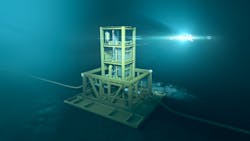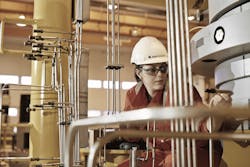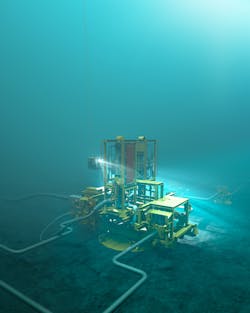Subsea multiphase pump solution could unlock borderline tieback projects
Subsea multiphase pumps are widely recognized as an effective tool for improved oil recovery, but take-up remains limited. According to Aker Solutions, this is due to the cost, complexity, and space constraints of the pumping systems, topsides support equipment, and surface-seafloor connections.
The company intends to change these perceptions by collaborating with FSubsea to create what they claim will be the world’s first ‘topside-less’ multiphase boosting system, FASTsubsea X. The development will combine the advanced features of Aker Solutions’ proven MultiBooster semi-axial impeller pump design with FSubsea’s Hydromag technology. Following approval for the co-operation from Norway’s competition authorities last April, early development and concept maturing began last summer; in January this year, the project entered a more active concept development phase. Aside from internal financing, the partnership - named FASTsubsea - secured funding last December from Norway’s Demo 2000 support program for development and testing of innovative petroleum products for petroleum. FASTsubsea is also pursuing sponsorship from offshore oil companies.
In a position paper on the new development, the two partners list the negatives that have restricted subsea multiphase pumps to less than 1% of active subsea fields (as stated in a recent report by INTECSEA and Rystad Energy). The associated topsides kit - weighing up to 500 t and occupying up to 200 sq m (2,153 sq ft) of deck space - can render certain tiebacks sub-economic, particularly on existing topsides. Other factors include the need for:
• One electric variable-speed drive (VSD) per pump, with dedicated cables
• Hydraulic power units (HPUs) supplying barrier fluid oil or other hydraulic mixtures to cool/lubricate mechanical shaft seals
• Dedicated and costly umbilicals supplying the barrier fluid to the pumps
• Ex-proofing equipment (i.e. coolers).
These factors are said to be common to all currently qualified seabed multiphase pumps; depending on the water depth, step-out distance and number of pumps, the overall pump system cost including installation and topsides modification can typically range from $50-80 million.
At the same time, most end-users see potential to increase recovery from new and existing subsea wells of oil and gas if subsea multiphase pumping can be simplified to be more autonomous (less dependent on topsides support systems) and more reliable. Both are priorities for FASTsubsea, which will seek to qualify FASTsubsea X as the most effective IOR tool available for tiebacks, brownfield, and marginal field developments.
Aker Solutions started development of its Multibooster subsea multiphase pump in 2012. The system - most recently qualified to TRL-5, API 17 - is designed to handle various types of hydrocarbon liquids up to 100% gas volume fractions. FSubsea’s hermetically-sealed Hydromag technology (targeted for TRL-4 in 2020) is said to provide barrier fluid-less variable speed operations to any seabed pumping system. It comprises a motor and a variable-speed torque converter integrated with a high-performance permanent magnetic coupling. A prototype system was due to undergo tests as part of an existing Demo 2000 project.
The two companies have granted FASTsubsea an exclusive license to qualify the FASTsubsea X pump system. Long-term goals include bringing down capex by up to 50% and delivering an improved reliability, compared to existing subsea multiphase pumps; scaling back the area occupied by associated equipment on the platform topsides, leading to weight savings in the range of 200-500 metric tons (220-551 tons); dispensing altogether with hydraulic tube lines in the umbilicals and complex barrier-fluid systems, with no risk of uncontrolled hydraulic fluid releases; and a single power cable for multiple pumps.
In order to qualify the system to TRL-4 (API 17), ready to operate on commercial tieback, brownfield and greenfield projects, the joint venture will follow six main steps:
• Full concept design for pump module, including resolving critical challenges
• Detail design of pump module
• Procurement of long-lead equipment for prototype module
• Construction and testing of two-stage pump impellers to verify the anticipated performance of the full-scale prototype pump package
• Assembly of full-scale module prototype with integrated Hydromag drive unit
• Testing of module prototype followed by final report to participants.
The pump module will feature a pump inlet flow mixer, a drive-pump unit and a liquid extraction device on the discharge. Its magnetic coupling will isolate the cooling and lubrication fluid inside the drive section from the pumping section: this requires process fluid lubrication and cooling for the rotating components. The main technical challenges foreseen are:
• The section of the magnetic coupling exposed to the pumped medium will require cooling due to friction losses between static and rotating parts. Cooling will be provided by the pumped multiphase fluid itself, but care will be needed to ensure the correct quality of fluid is applied for all the pump’s operating modes
• Selection of process-lubricated thrust/axial bearings that ensure performance of in all operating modes, including transient and process upset conditions
• Process design/equipment selection to provide safe pumping conditions, in particular for bearings/seals/surfaces where heat is dissipated. The intention is to separate the liquid in the multiphase pump fluid discharge then treat it prior to routing it into the pump unit for cooling/lubrication. This also means fine-tuning the Hydromag unit’s control and performance to suit the selected multiphase flow regimes
• All hydrocarbon pumping applications will have to take into account a quantity of solids within the pumped medium. It is important to prevent these solids being routed into the cooling/lubrication pathways and to provide a means of removing sand from the liquid extraction unit and/or flow inlet mixer.
Development and testing will be in accordance with API 17N and DNV RP A203 (New Technology Qualification, and all tests and demonstrations will be conducted at Aker Solutions’ Tranby complex, where a multiphase test loop will be used for qualification of the FASTsubsea X prototype. A test rig is also available for trials of the scaled-down impellers that will be used for the prototype. In parallel with development of the prototype, a two-stage pump will be manufactured and tested.
Once the design has attained sufficient maturity, the JIP participants will be asked to sanction increased spending in order for the program to proceed to the final stages, namely hardware procurement followed by assembly and qualification testing.
Development timeframe
According to Alexander Fuglesang, CEO of FSubsea, prior to obtaining approval to start the project in earnest last April “the two companies already had a good idea what to develop based on their existing technology platform.” Now that concept engineering and de-risking is under way, he added, the timeframe for completion of this and the six other milestones - detailed engineering, procurement of hardware, manufacturing and assembly of test units, impeller mapping test, prototype qualification testing, and final reporting - should be around two years from signing of an agreement with interested oil company backers. “Our targets are to minimize the cost and to maximize performance within a 2-MW shaft power range,” Fuglesang said. “The pump section can be configured for a range of flow rates, pressures, and gas volume fractions [GVFs].”
Later this year, FSubsea aims to achieve TRL4 for its Hydromag motor/torque converter/magnetic coupling system. This will be tested to API 610 using a qualified pump hydraulic cartridge, supplied by Ruhrpumpen, again with Demo 2000 support, Fuglesang explained: “Trials will involve substantial testing of each sub-component (pump motor, torque converter, magnetic coupling) followed by a test of the Hydromag drive unit (motor, torque converter, magnetic coupling) followed by a pit test by FSubsea in Oslo of the complete single-phase pumping unit. •
About the Author
Jeremy Beckman
Editor, Europe
Jeremy Beckman has been Editor Europe, Offshore since 1992. Prior to joining Offshore he was a freelance journalist for eight years, working for a variety of electronics, computing and scientific journals in the UK. He regularly writes news columns on trends and events both in the NW Europe offshore region and globally. He also writes features on developments and technology in exploration and production.




